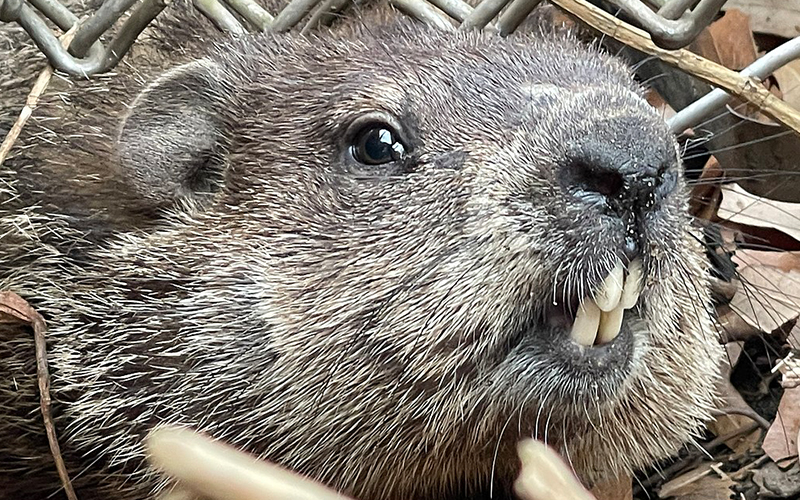Whistle pig, woodchuck, forest marmot, and land beaver are some of the names for what is most commonly called a groundhog or woodchuck.
We only see groundhogs from mid-April until mid-October. The rest of the year groundhogs are in torpor sleep under ground.
During this period, groundhogs go into a dormant stage: they lose a quarter of their body weight. Their body temperature decreases by 60 degrees F and their heart rate slows to only 5 or 10 beats a minute.
THE FOUR INCISORS
In warmer climates groundhogs can be above ground most of the year. When groundhogs emerge in the spring they start to feed immediately on the new nutritious grasses and new growth.
Groundhogs have four incisors. They are white, very hard, sharp and the top two keep growing sometimes a foot or more if the woodchuck does not gnaw on leaves, grass, bark and wood.
To prepare for hibernation, these diurnal feeders feast all summer long on plants. They do not eat any form of meat, being mostly vegetarian. To a lesser degree groundhogs forage on insects such as beetles and grasshoppers.
SOLITARY LIVES
Groundhogs stay mainly to themselves. Sometimes two or three females might be together, but males live solitary lives. In the summer young feed and play together.
Classified as ground squirrels, groundhogs frequent northern New England in meadows, dry hillside slopes, pastures and sometimes even backyards.
These underground homes can be up to 6-feet deep and have tunnels running over 14-feet long. There are chambers for food storage, sleeping, waste disposal and raising young.
Laura C. Martin says in her book “Wildlife Folklore,” that the Mohawks believed that in the old days animals and people lived underground. Until one day the fire god, Gamawagehaha, saw a tiny crack in the earth’s surface and went to investigate. He crawled through the crack up into the air and light above and returned to tell everyone of the beautiful place he had seen. One by one the animals and people crawled through the crack to live above ground. All except the groundhog who was happy and content to live deep in in his den.
GERMAN TRADITION
Groundhog Day is always February 2 as that is midway between winter and summer solstices.
The observance of this day dates back to before Christ when pagan ceremonies took place in Europe.
In Germany it was believed that if an animal such as a hedgehog saw its shadow it would go back into its tunnels and winter would still last for another six weeks.
The Pennsylvania immigrants brought this tradition to the new country where it has been observed since 1887.
WOODCHUCK SONG
“How much wood would a woodchuck chuck
if a woodchuck could chuck wood?
He would chuck, he would, as much as he could
and as much wood as a woodchuck would
if a woodchuck could chuck wood.”
The “Woodchuck” tongue twister is from the refrain of the “Woodchuck Song” NYC Casino theater.
There are more verses. Look it up!







